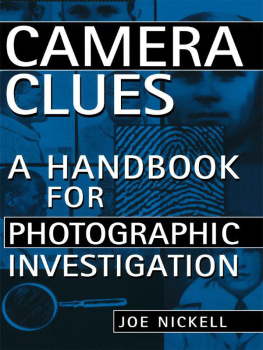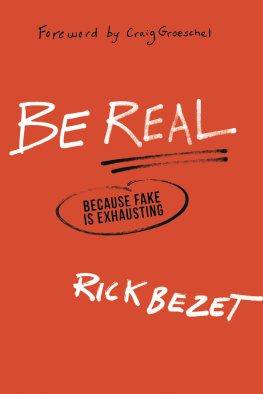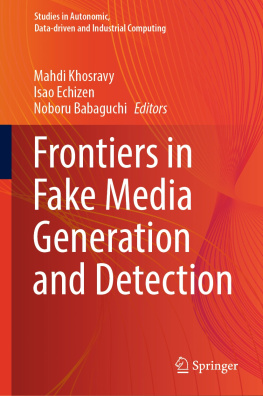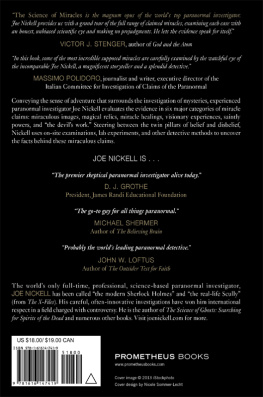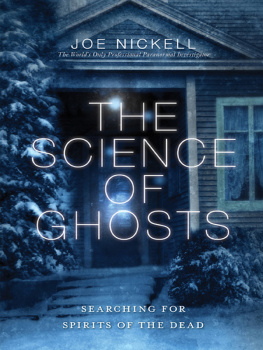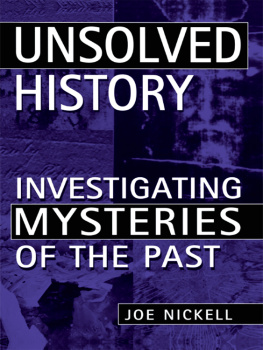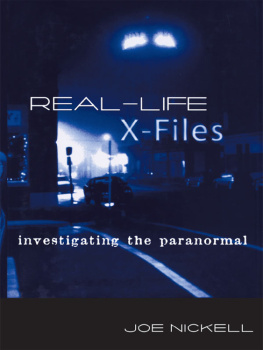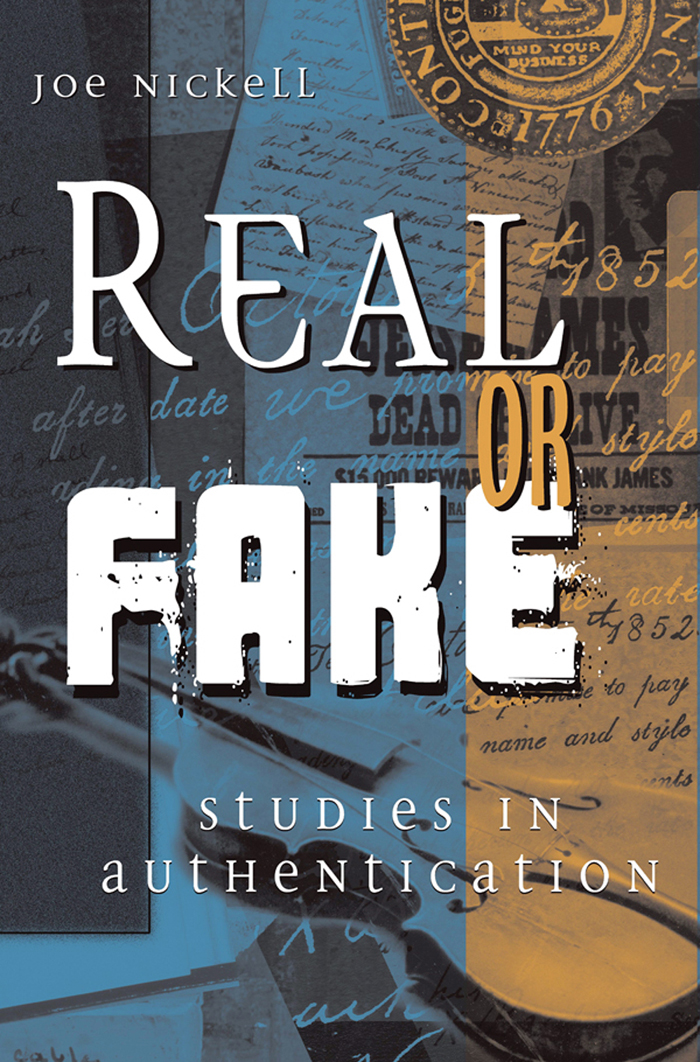REAL OR FAKE
REAL OR FAKE

Studies in Authentication
Joe Nickell

Copyright 2009 by The University Press of Kentucky
Scholarly publisher for the Commonwealth,
serving Bellarmine University, Berea College, Centre
College of Kentucky, Eastern Kentucky University,
The Filson Historical Society, Georgetown College,
Kentucky Historical Society, Kentucky State University,
Morehead State University, Murray State University,
Northern Kentucky University, Transylvania University,
University of Kentucky, University of Louisville,
and Western Kentucky University.
All rights reserved.
Editorial and Sales Offices: The University Press of Kentucky
663 South Limestone Street, Lexington, Kentucky 40508-4008
www.kentuckypress.com
09 10 11 12 13 5 4 3 2 1
Library of Congress Cataloging-in-Publication Data
Nickell, Joe.
Real or fake : studies in authentication / Joe Nickell.
p. cm.
Includes bibliographical references and index.
ISBN 978-0-8131-2534-3 (hardcover : alk. paper)
1. Forgery. 2. Fraud. I. Title.
HV6675.N53 2009
364.16'68dc22 2008051816
This book is printed on acid-free recycled paper meeting
the requirements of the American National Standard
for Permanence in Paper for Printed Library Materials.

Manufactured in the United States of America.

| Member of the Association of
American University Presses |
CONTENTS
ILLUSTRATIONS
ACKNOWLEDGMENTS
The work featured in this book spans decades, and I must acknowledge the efforts of many people. In addition to those mentioned in the text, I am especially grateful to some who have passed away: autograph expert Charles Hamilton, who tutored me in the fine art of forgery and its detection; photographer Robert H. van Outer, whose expertise was always at my service; and microanalyst Walter C. McCrone, who provided inspiration with his sophisticated analyses and his motto, Think Small.
I am also indebted to many experts for both their professional assistance and their friendship. Among them are librarian Timothy Binga (Center for Inquiry), forensic anthropologist Emily Craig, forensic analyst John F. Fischer, identification expert Alfred V. Iannarelli, ink chemist Antonio Cantu (U.S. Secret Service, retired), forensic document examiner Gideon Epstein (U.S. Bureau of Immigration and Naturalization, retired), and historical manuscripts authority Kenneth W. Rendell. Gerald Richards (formerly a forensic document examiner for the FBI) was kind enough to read the manuscript and make many helpful suggestions, as was Antonio Cantu. Any errors or deficiencies are, of course, my own responsibility.
I am further indebted to the editors and publishers of several of my earlier works from which portions of this treatise were abridged or adapted (listed in the references under my name).
I am grateful to Paul E. Loynes for his expert manuscript preparation. I also wish to thank the entire crew at the University Press of Kentucky for their continued encouragement, professional assistance, and friendship. They are a pleasure to work with.
For their patience and support, as always, I thank my colleagues at the Center for Inquirynotably, chairman Paul Kurtz, CEO Ronald Lindsay, and CSI executive director Barry Karrand my family, including my wife, Diana Harris; my daughter, Cherie Roycroft; and my grandchildren, Chase, Tyner, and Alexis.
INTRODUCTION
The distant past presents us with countless mysteries that challenge our collective intellect and imagination. Time typically obscures the contexts, erases the links, and removes the ancillary evidence that would allow us to fully comprehend ancient events. Yet the past can also yield fragmentseven whole treasuresthat serve as clues, pieces of the puzzles that engage us.
The Recovered Past
For years, I have kept a file labeled The Recovered Past. Here are some examples of the clippings it contains.
Found: A Legendary City that History Forgot (1995) reports on a remarkable discovery by a team of archaeologists led by UCLAs Giorgio Buccellati. After eight years of excavation, they located Urkesh, the fabled capital of the Hurrians, beneath a modern town in Syria. Many historians had doubted the existence of either the people or the city, due to a paucity of evidence: only brief mention in the Old Testament and other ancient literature and a pair of bronze lions inscribed Urkesh. The archaeologists discovered clay figures and pottery, metal tools, and the signature seals of the ancient citys king and queen dating from some 4,300 years ago. Buccellati observed that the discovery would give the neglected Hurrians and their rich city their deserved place in history. The footnote will become a chapter.
Unknown Goya Canvas Discovered (1996) relates how a previously unrecorded painting by Spanish master Francisco de Goya (17461828) was found by workers renovating a government building in Madrid. The eight- by six-foot canvas, discovered in an attic storeroom, depicts redeemed souls being swept from purgatory up into heaven. It was tentatively dated to the early 1780s, when Goya painted mostly religious themes. A Prado museum curator who helped authenticate the painting enthused, From the moment we saw it, it was marvelous.
Smithsonian Acquires Long-Lost Photo of Noted Abolitionist (Ruane 1996) details how a missing portrait of radical abolitionist John Brown resurfaced after being presumed lost for most of the twentieth century. A pair of collectors spotted the daguerreotypethe original of an image thought to exist only in copiesat an auction house in Pittsburgh. It had been mistaken for the image of obscure nineteenth-century novelist George Lippard. The collectors purchased it for $12,000 and then sold it to the Smithsonian for $129,000. Curator of photographs Mary Panzer, noting that Browns image had been recorded by black daguerreotypist Augustus Washington at a time when both men were attempting to rid America of slavery, stated: You dont come across something this powerful very often. I feel very fortunate. I dont think there will be anything more important that I will ever buy for any museum anywhere.
Mary Shelleys Lost Childrens Story Found in Italian Palazzo (1998) presents the discovery of a thirty-four-page manuscript by the famed author of Frankenstein and wife of poet Percy Bysshe Shelley. The story, known to have existed from a mention in Mary Shelleys journal and in a letter written by her father, was assumed to be irretrievably lost. However, it was found by Andres and Cristina Dazzi in a wooden chest in a neglected room of the family mansion in the Tuscany hills. Andres was descended from Lady Mountcashell, a member of the Shelleys circle when they sojourned in Italy. The story, titled Maurice, or the Fishers Cot, had been written for Lady Mountcashells eleven-year-old daughter. It is a morality tale about a boy who runs away from a cruel stepfather and is adopted by a grandfatherly fisherman. Two experts authenticated the manuscript. Claire Tomalin, author of



